Analysis of Air Recirculation & Heat Loss in Duct Room System
VerifiedAdded on 2023/06/07
|19
|4107
|450
Report
AI Summary
This report details an analysis of air recirculation through a duct room system, focusing on heat loss calculations in Tests A and B. Test A examines heat loss between temperatures T2 and T4, and T4 and T5, determining values at different preheater power levels. A comparison between Tests A and B reveals higher heat loss in Test B due to greater temperature changes. The report also calculates the power dissipated by the preheater in both tests. The methodology outlines the equipment and procedure used, with assumptions including dry air, uniform flow, and the ideal gas law. The results section presents detailed calculations, assumptions, and observations regarding the impact of temperature changes on heat loss within the air conditioning cooling system unit. This comprehensive analysis provides valuable insights into the thermal performance of air recirculation systems.
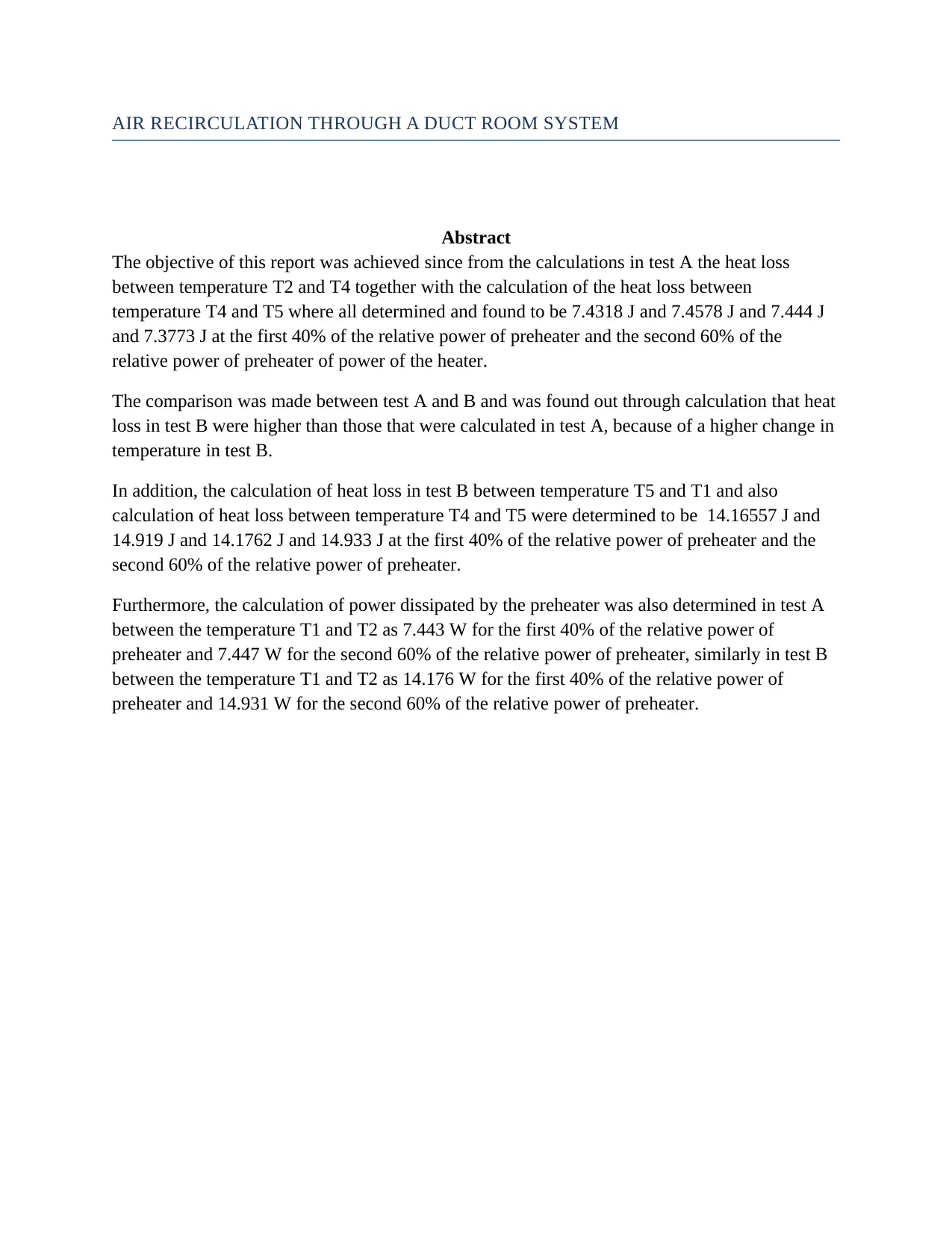
AIR RECIRCULATION THROUGH A DUCT ROOM SYSTEM
Abstract
The objective of this report was achieved since from the calculations in test A the heat loss
between temperature T2 and T4 together with the calculation of the heat loss between
temperature T4 and T5 where all determined and found to be 7.4318 J and 7.4578 J and 7.444 J
and 7.3773 J at the first 40% of the relative power of preheater and the second 60% of the
relative power of preheater of power of the heater.
The comparison was made between test A and B and was found out through calculation that heat
loss in test B were higher than those that were calculated in test A, because of a higher change in
temperature in test B.
In addition, the calculation of heat loss in test B between temperature T5 and T1 and also
calculation of heat loss between temperature T4 and T5 were determined to be 14.16557 J and
14.919 J and 14.1762 J and 14.933 J at the first 40% of the relative power of preheater and the
second 60% of the relative power of preheater.
Furthermore, the calculation of power dissipated by the preheater was also determined in test A
between the temperature T1 and T2 as 7.443 W for the first 40% of the relative power of
preheater and 7.447 W for the second 60% of the relative power of preheater, similarly in test B
between the temperature T1 and T2 as 14.176 W for the first 40% of the relative power of
preheater and 14.931 W for the second 60% of the relative power of preheater.
Abstract
The objective of this report was achieved since from the calculations in test A the heat loss
between temperature T2 and T4 together with the calculation of the heat loss between
temperature T4 and T5 where all determined and found to be 7.4318 J and 7.4578 J and 7.444 J
and 7.3773 J at the first 40% of the relative power of preheater and the second 60% of the
relative power of preheater of power of the heater.
The comparison was made between test A and B and was found out through calculation that heat
loss in test B were higher than those that were calculated in test A, because of a higher change in
temperature in test B.
In addition, the calculation of heat loss in test B between temperature T5 and T1 and also
calculation of heat loss between temperature T4 and T5 were determined to be 14.16557 J and
14.919 J and 14.1762 J and 14.933 J at the first 40% of the relative power of preheater and the
second 60% of the relative power of preheater.
Furthermore, the calculation of power dissipated by the preheater was also determined in test A
between the temperature T1 and T2 as 7.443 W for the first 40% of the relative power of
preheater and 7.447 W for the second 60% of the relative power of preheater, similarly in test B
between the temperature T1 and T2 as 14.176 W for the first 40% of the relative power of
preheater and 14.931 W for the second 60% of the relative power of preheater.
Paraphrase This Document
Need a fresh take? Get an instant paraphrase of this document with our AI Paraphraser
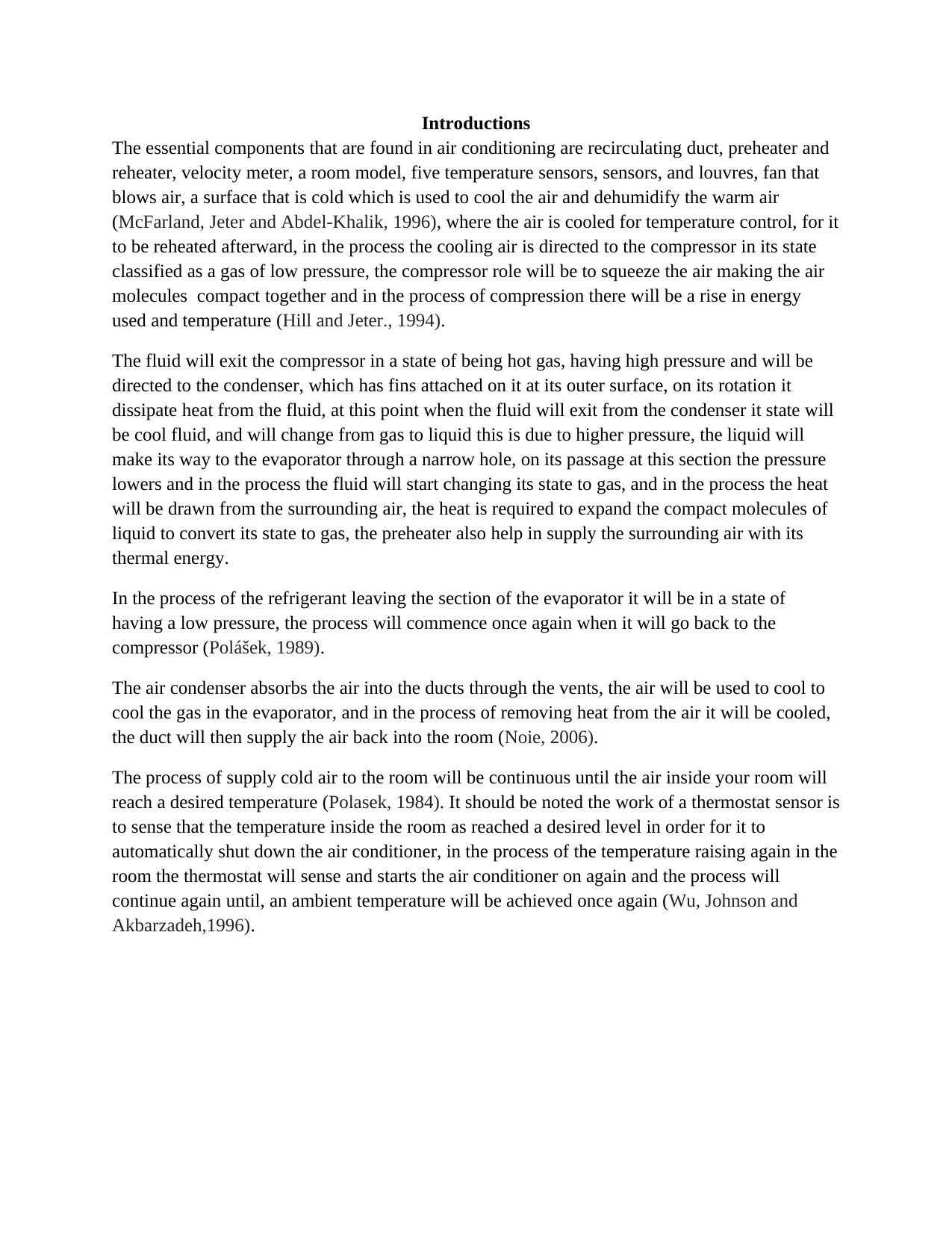
Introductions
The essential components that are found in air conditioning are recirculating duct, preheater and
reheater, velocity meter, a room model, five temperature sensors, sensors, and louvres, fan that
blows air, a surface that is cold which is used to cool the air and dehumidify the warm air
(McFarland, Jeter and Abdel-Khalik, 1996), where the air is cooled for temperature control, for it
to be reheated afterward, in the process the cooling air is directed to the compressor in its state
classified as a gas of low pressure, the compressor role will be to squeeze the air making the air
molecules compact together and in the process of compression there will be a rise in energy
used and temperature (Hill and Jeter., 1994).
The fluid will exit the compressor in a state of being hot gas, having high pressure and will be
directed to the condenser, which has fins attached on it at its outer surface, on its rotation it
dissipate heat from the fluid, at this point when the fluid will exit from the condenser it state will
be cool fluid, and will change from gas to liquid this is due to higher pressure, the liquid will
make its way to the evaporator through a narrow hole, on its passage at this section the pressure
lowers and in the process the fluid will start changing its state to gas, and in the process the heat
will be drawn from the surrounding air, the heat is required to expand the compact molecules of
liquid to convert its state to gas, the preheater also help in supply the surrounding air with its
thermal energy.
In the process of the refrigerant leaving the section of the evaporator it will be in a state of
having a low pressure, the process will commence once again when it will go back to the
compressor (Polášek, 1989).
The air condenser absorbs the air into the ducts through the vents, the air will be used to cool to
cool the gas in the evaporator, and in the process of removing heat from the air it will be cooled,
the duct will then supply the air back into the room (Noie, 2006).
The process of supply cold air to the room will be continuous until the air inside your room will
reach a desired temperature (Polasek, 1984). It should be noted the work of a thermostat sensor is
to sense that the temperature inside the room as reached a desired level in order for it to
automatically shut down the air conditioner, in the process of the temperature raising again in the
room the thermostat will sense and starts the air conditioner on again and the process will
continue again until, an ambient temperature will be achieved once again (Wu, Johnson and
Akbarzadeh,1996).
The essential components that are found in air conditioning are recirculating duct, preheater and
reheater, velocity meter, a room model, five temperature sensors, sensors, and louvres, fan that
blows air, a surface that is cold which is used to cool the air and dehumidify the warm air
(McFarland, Jeter and Abdel-Khalik, 1996), where the air is cooled for temperature control, for it
to be reheated afterward, in the process the cooling air is directed to the compressor in its state
classified as a gas of low pressure, the compressor role will be to squeeze the air making the air
molecules compact together and in the process of compression there will be a rise in energy
used and temperature (Hill and Jeter., 1994).
The fluid will exit the compressor in a state of being hot gas, having high pressure and will be
directed to the condenser, which has fins attached on it at its outer surface, on its rotation it
dissipate heat from the fluid, at this point when the fluid will exit from the condenser it state will
be cool fluid, and will change from gas to liquid this is due to higher pressure, the liquid will
make its way to the evaporator through a narrow hole, on its passage at this section the pressure
lowers and in the process the fluid will start changing its state to gas, and in the process the heat
will be drawn from the surrounding air, the heat is required to expand the compact molecules of
liquid to convert its state to gas, the preheater also help in supply the surrounding air with its
thermal energy.
In the process of the refrigerant leaving the section of the evaporator it will be in a state of
having a low pressure, the process will commence once again when it will go back to the
compressor (Polášek, 1989).
The air condenser absorbs the air into the ducts through the vents, the air will be used to cool to
cool the gas in the evaporator, and in the process of removing heat from the air it will be cooled,
the duct will then supply the air back into the room (Noie, 2006).
The process of supply cold air to the room will be continuous until the air inside your room will
reach a desired temperature (Polasek, 1984). It should be noted the work of a thermostat sensor is
to sense that the temperature inside the room as reached a desired level in order for it to
automatically shut down the air conditioner, in the process of the temperature raising again in the
room the thermostat will sense and starts the air conditioner on again and the process will
continue again until, an ambient temperature will be achieved once again (Wu, Johnson and
Akbarzadeh,1996).
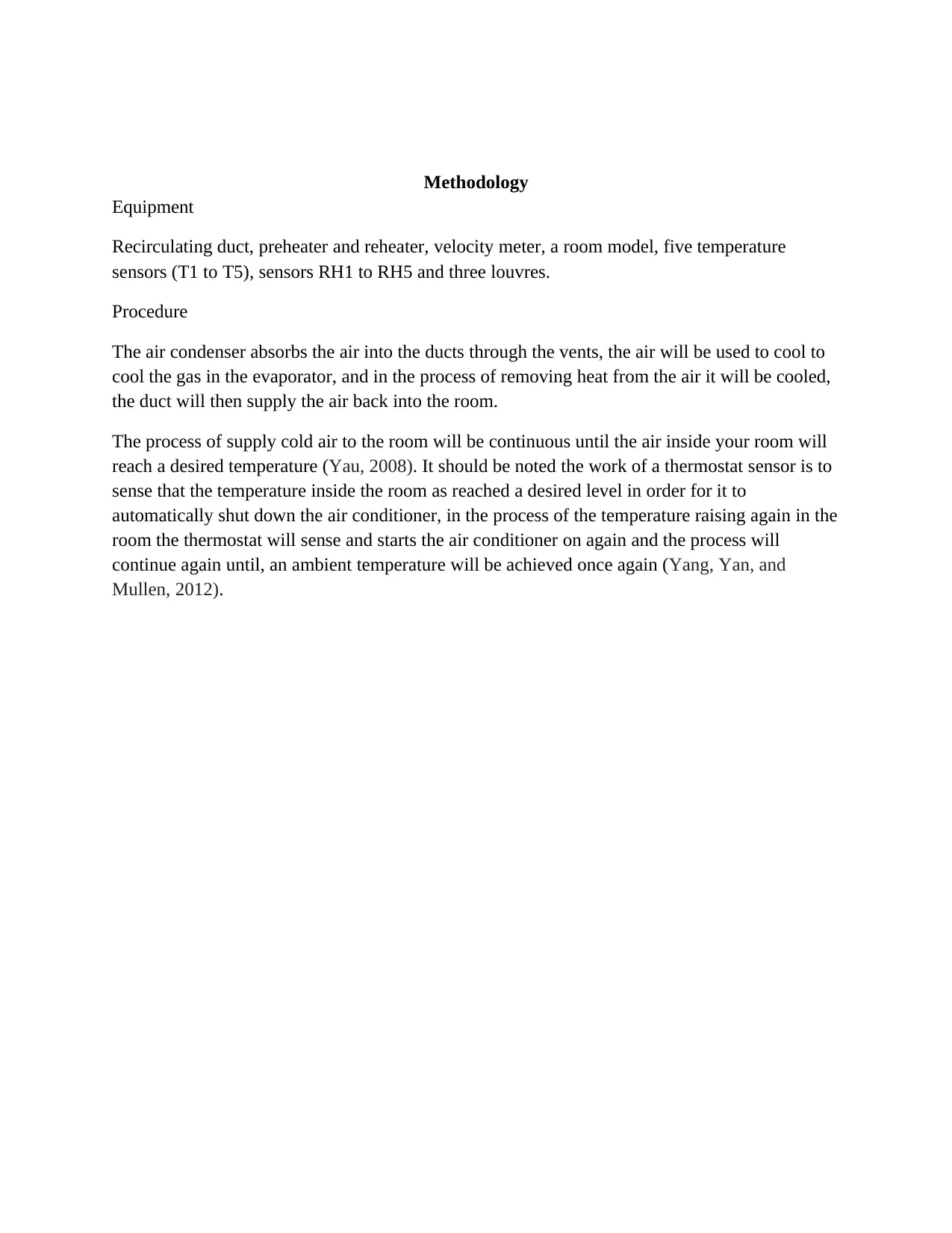
Methodology
Equipment
Recirculating duct, preheater and reheater, velocity meter, a room model, five temperature
sensors (T1 to T5), sensors RH1 to RH5 and three louvres.
Procedure
The air condenser absorbs the air into the ducts through the vents, the air will be used to cool to
cool the gas in the evaporator, and in the process of removing heat from the air it will be cooled,
the duct will then supply the air back into the room.
The process of supply cold air to the room will be continuous until the air inside your room will
reach a desired temperature (Yau, 2008). It should be noted the work of a thermostat sensor is to
sense that the temperature inside the room as reached a desired level in order for it to
automatically shut down the air conditioner, in the process of the temperature raising again in the
room the thermostat will sense and starts the air conditioner on again and the process will
continue again until, an ambient temperature will be achieved once again (Yang, Yan, and
Mullen, 2012).
Equipment
Recirculating duct, preheater and reheater, velocity meter, a room model, five temperature
sensors (T1 to T5), sensors RH1 to RH5 and three louvres.
Procedure
The air condenser absorbs the air into the ducts through the vents, the air will be used to cool to
cool the gas in the evaporator, and in the process of removing heat from the air it will be cooled,
the duct will then supply the air back into the room.
The process of supply cold air to the room will be continuous until the air inside your room will
reach a desired temperature (Yau, 2008). It should be noted the work of a thermostat sensor is to
sense that the temperature inside the room as reached a desired level in order for it to
automatically shut down the air conditioner, in the process of the temperature raising again in the
room the thermostat will sense and starts the air conditioner on again and the process will
continue again until, an ambient temperature will be achieved once again (Yang, Yan, and
Mullen, 2012).
⊘ This is a preview!⊘
Do you want full access?
Subscribe today to unlock all pages.

Trusted by 1+ million students worldwide
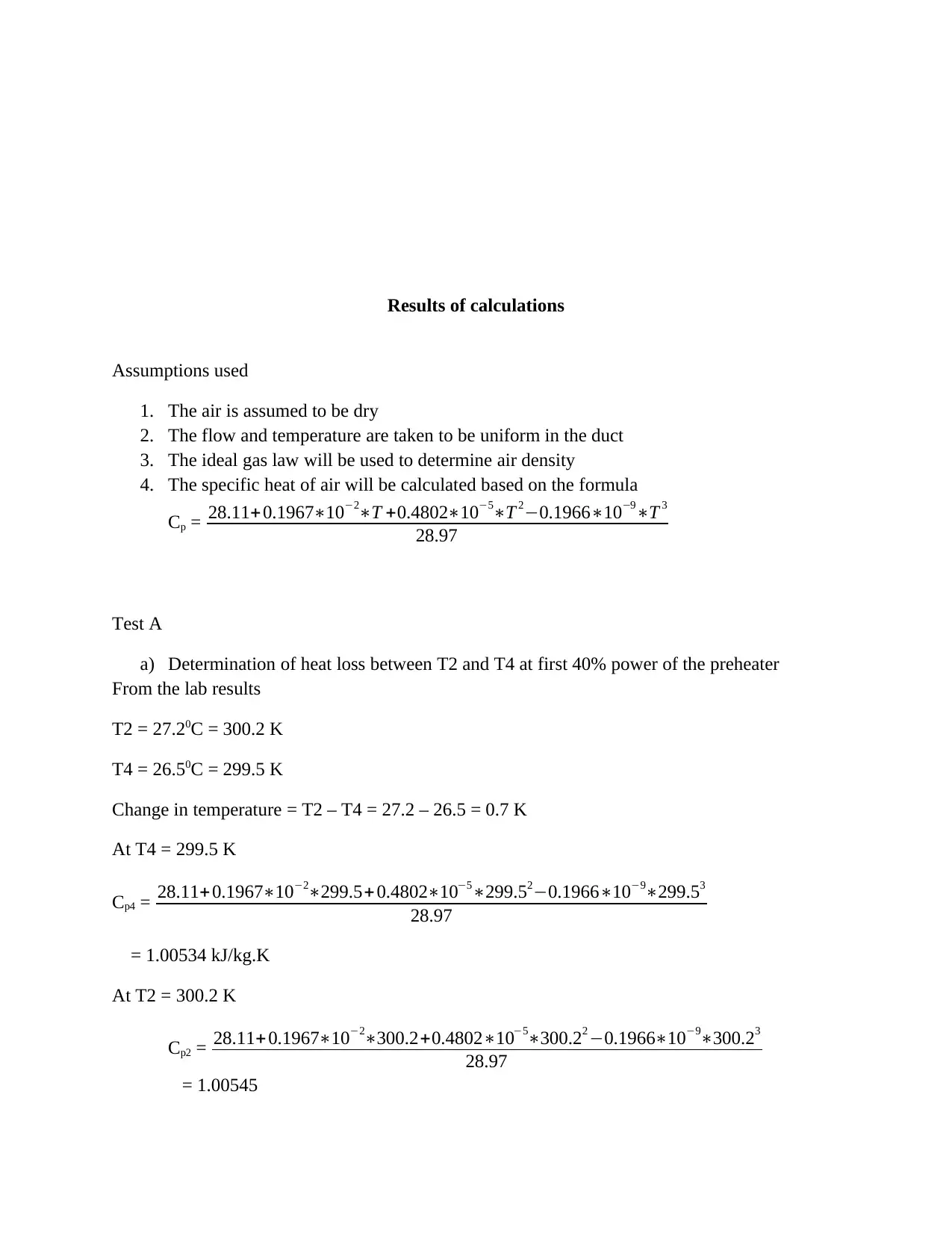
Results of calculations
Assumptions used
1. The air is assumed to be dry
2. The flow and temperature are taken to be uniform in the duct
3. The ideal gas law will be used to determine air density
4. The specific heat of air will be calculated based on the formula
Cp = 28.11+0.1967∗10−2∗T +0.4802∗10−5∗T 2−0.1966∗10−9∗T 3
28.97
Test A
a) Determination of heat loss between T2 and T4 at first 40% power of the preheater
From the lab results
T2 = 27.20C = 300.2 K
T4 = 26.50C = 299.5 K
Change in temperature = T2 – T4 = 27.2 – 26.5 = 0.7 K
At T4 = 299.5 K
Cp4 = 28.11+0.1967∗10−2∗299.5+ 0.4802∗10−5∗299.52−0.1966∗10−9∗299.53
28.97
= 1.00534 kJ/kg.K
At T2 = 300.2 K
Cp2 = 28.11+ 0.1967∗10−2∗300.2+0.4802∗10−5∗300.22 −0.1966∗10−9∗300.23
28.97
= 1.00545
Assumptions used
1. The air is assumed to be dry
2. The flow and temperature are taken to be uniform in the duct
3. The ideal gas law will be used to determine air density
4. The specific heat of air will be calculated based on the formula
Cp = 28.11+0.1967∗10−2∗T +0.4802∗10−5∗T 2−0.1966∗10−9∗T 3
28.97
Test A
a) Determination of heat loss between T2 and T4 at first 40% power of the preheater
From the lab results
T2 = 27.20C = 300.2 K
T4 = 26.50C = 299.5 K
Change in temperature = T2 – T4 = 27.2 – 26.5 = 0.7 K
At T4 = 299.5 K
Cp4 = 28.11+0.1967∗10−2∗299.5+ 0.4802∗10−5∗299.52−0.1966∗10−9∗299.53
28.97
= 1.00534 kJ/kg.K
At T2 = 300.2 K
Cp2 = 28.11+ 0.1967∗10−2∗300.2+0.4802∗10−5∗300.22 −0.1966∗10−9∗300.23
28.97
= 1.00545
Paraphrase This Document
Need a fresh take? Get an instant paraphrase of this document with our AI Paraphraser
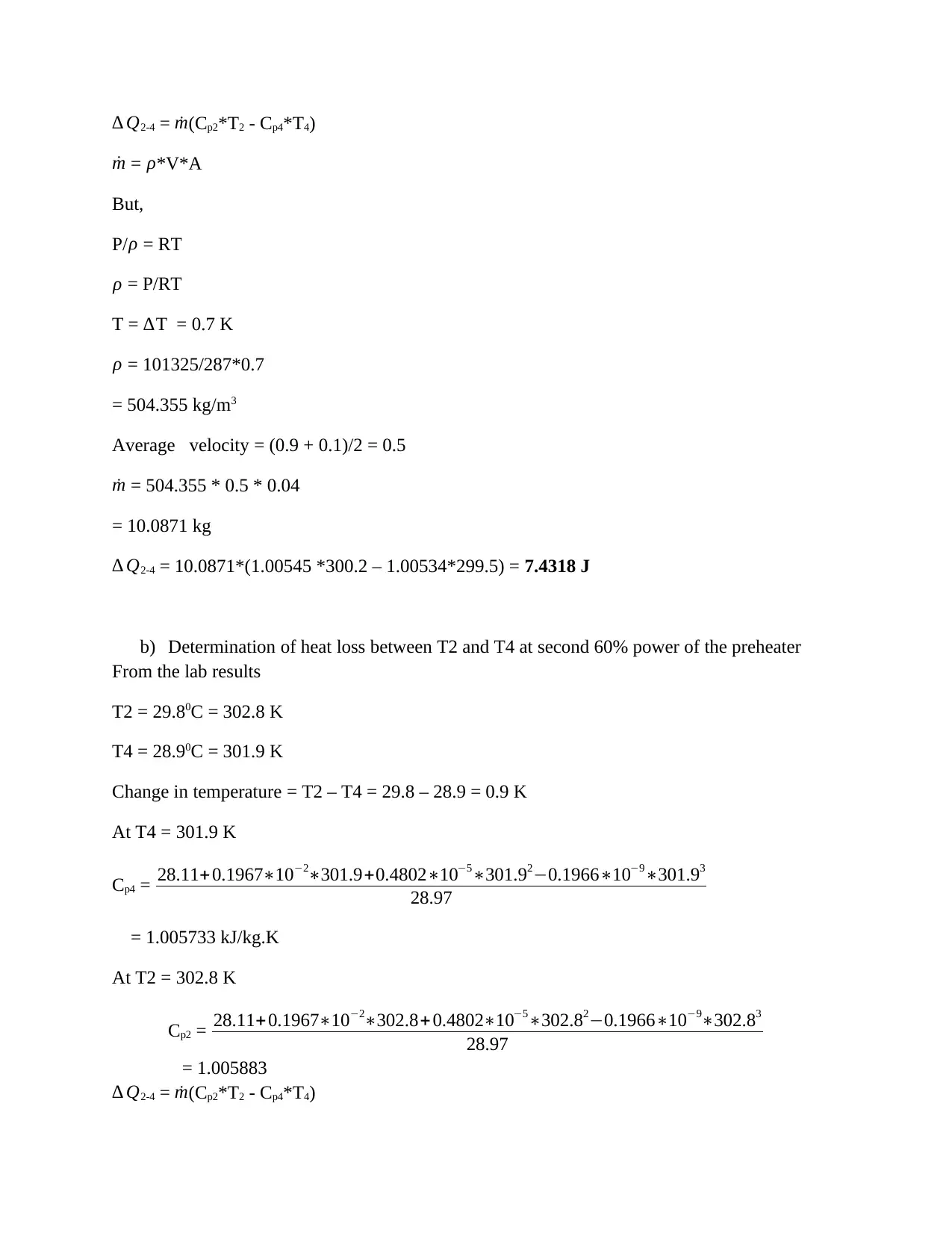
∆ Q2-4 = ˙m(Cp2*T2 - Cp4*T4)
˙m = ρ*V*A
But,
P/ ρ = RT
ρ = P/RT
T = ∆T = 0.7 K
ρ = 101325/287*0.7
= 504.355 kg/m3
Average velocity = (0.9 + 0.1)/2 = 0.5
˙m = 504.355 * 0.5 * 0.04
= 10.0871 kg
∆ Q2-4 = 10.0871*(1.00545 *300.2 – 1.00534*299.5) = 7.4318 J
b) Determination of heat loss between T2 and T4 at second 60% power of the preheater
From the lab results
T2 = 29.80C = 302.8 K
T4 = 28.90C = 301.9 K
Change in temperature = T2 – T4 = 29.8 – 28.9 = 0.9 K
At T4 = 301.9 K
Cp4 = 28.11+0.1967∗10−2∗301.9+0.4802∗10−5∗301.92−0.1966∗10−9∗301.93
28.97
= 1.005733 kJ/kg.K
At T2 = 302.8 K
Cp2 = 28.11+0.1967∗10−2∗302.8+ 0.4802∗10−5∗302.82−0.1966∗10−9∗302.83
28.97
= 1.005883
∆ Q2-4 = ˙m(Cp2*T2 - Cp4*T4)
˙m = ρ*V*A
But,
P/ ρ = RT
ρ = P/RT
T = ∆T = 0.7 K
ρ = 101325/287*0.7
= 504.355 kg/m3
Average velocity = (0.9 + 0.1)/2 = 0.5
˙m = 504.355 * 0.5 * 0.04
= 10.0871 kg
∆ Q2-4 = 10.0871*(1.00545 *300.2 – 1.00534*299.5) = 7.4318 J
b) Determination of heat loss between T2 and T4 at second 60% power of the preheater
From the lab results
T2 = 29.80C = 302.8 K
T4 = 28.90C = 301.9 K
Change in temperature = T2 – T4 = 29.8 – 28.9 = 0.9 K
At T4 = 301.9 K
Cp4 = 28.11+0.1967∗10−2∗301.9+0.4802∗10−5∗301.92−0.1966∗10−9∗301.93
28.97
= 1.005733 kJ/kg.K
At T2 = 302.8 K
Cp2 = 28.11+0.1967∗10−2∗302.8+ 0.4802∗10−5∗302.82−0.1966∗10−9∗302.83
28.97
= 1.005883
∆ Q2-4 = ˙m(Cp2*T2 - Cp4*T4)
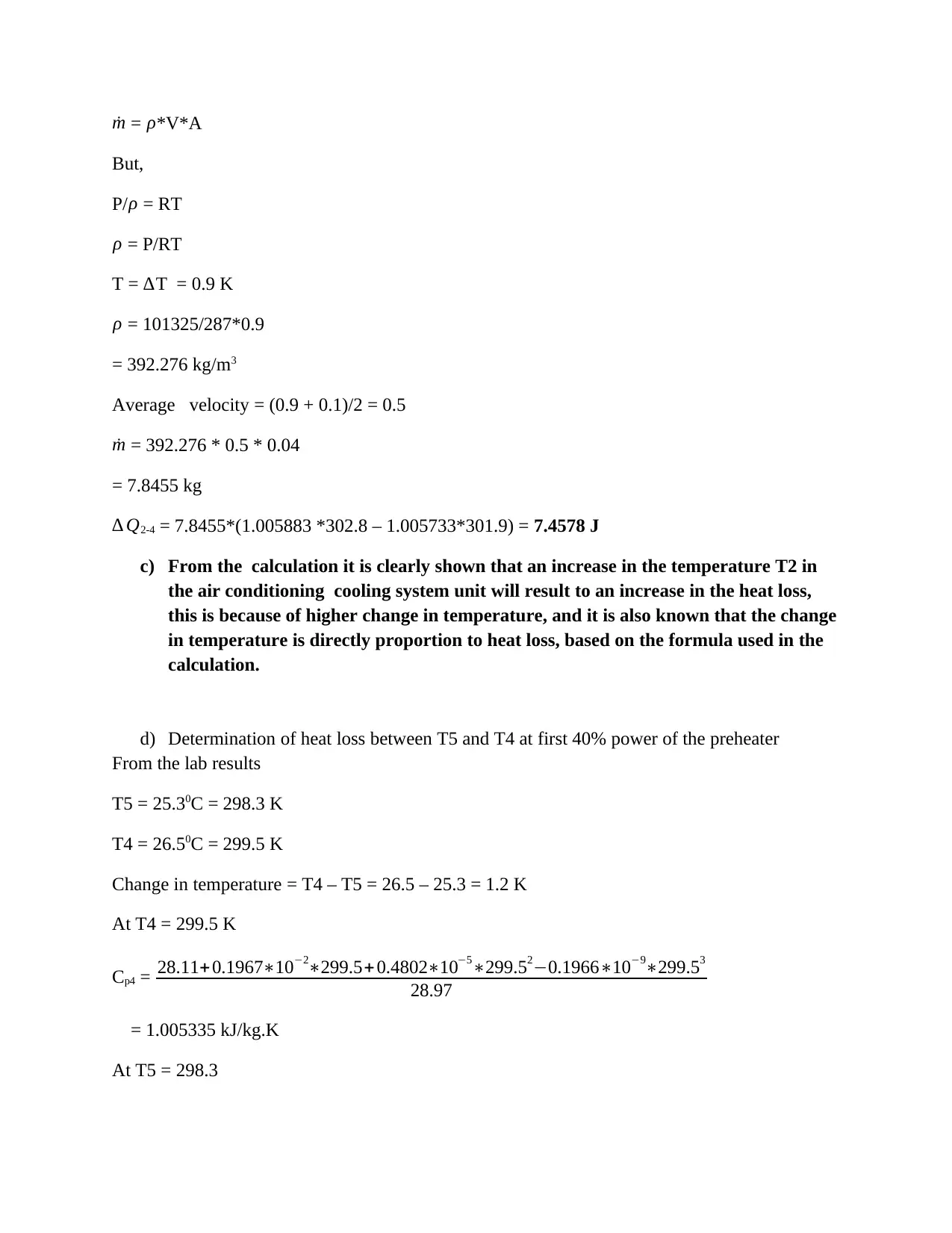
˙m = ρ*V*A
But,
P/ ρ = RT
ρ = P/RT
T = ∆T = 0.9 K
ρ = 101325/287*0.9
= 392.276 kg/m3
Average velocity = (0.9 + 0.1)/2 = 0.5
˙m = 392.276 * 0.5 * 0.04
= 7.8455 kg
∆ Q2-4 = 7.8455*(1.005883 *302.8 – 1.005733*301.9) = 7.4578 J
c) From the calculation it is clearly shown that an increase in the temperature T2 in
the air conditioning cooling system unit will result to an increase in the heat loss,
this is because of higher change in temperature, and it is also known that the change
in temperature is directly proportion to heat loss, based on the formula used in the
calculation.
d) Determination of heat loss between T5 and T4 at first 40% power of the preheater
From the lab results
T5 = 25.30C = 298.3 K
T4 = 26.50C = 299.5 K
Change in temperature = T4 – T5 = 26.5 – 25.3 = 1.2 K
At T4 = 299.5 K
Cp4 = 28.11+0.1967∗10−2∗299.5+ 0.4802∗10−5∗299.52−0.1966∗10−9∗299.53
28.97
= 1.005335 kJ/kg.K
At T5 = 298.3
But,
P/ ρ = RT
ρ = P/RT
T = ∆T = 0.9 K
ρ = 101325/287*0.9
= 392.276 kg/m3
Average velocity = (0.9 + 0.1)/2 = 0.5
˙m = 392.276 * 0.5 * 0.04
= 7.8455 kg
∆ Q2-4 = 7.8455*(1.005883 *302.8 – 1.005733*301.9) = 7.4578 J
c) From the calculation it is clearly shown that an increase in the temperature T2 in
the air conditioning cooling system unit will result to an increase in the heat loss,
this is because of higher change in temperature, and it is also known that the change
in temperature is directly proportion to heat loss, based on the formula used in the
calculation.
d) Determination of heat loss between T5 and T4 at first 40% power of the preheater
From the lab results
T5 = 25.30C = 298.3 K
T4 = 26.50C = 299.5 K
Change in temperature = T4 – T5 = 26.5 – 25.3 = 1.2 K
At T4 = 299.5 K
Cp4 = 28.11+0.1967∗10−2∗299.5+ 0.4802∗10−5∗299.52−0.1966∗10−9∗299.53
28.97
= 1.005335 kJ/kg.K
At T5 = 298.3
⊘ This is a preview!⊘
Do you want full access?
Subscribe today to unlock all pages.

Trusted by 1+ million students worldwide
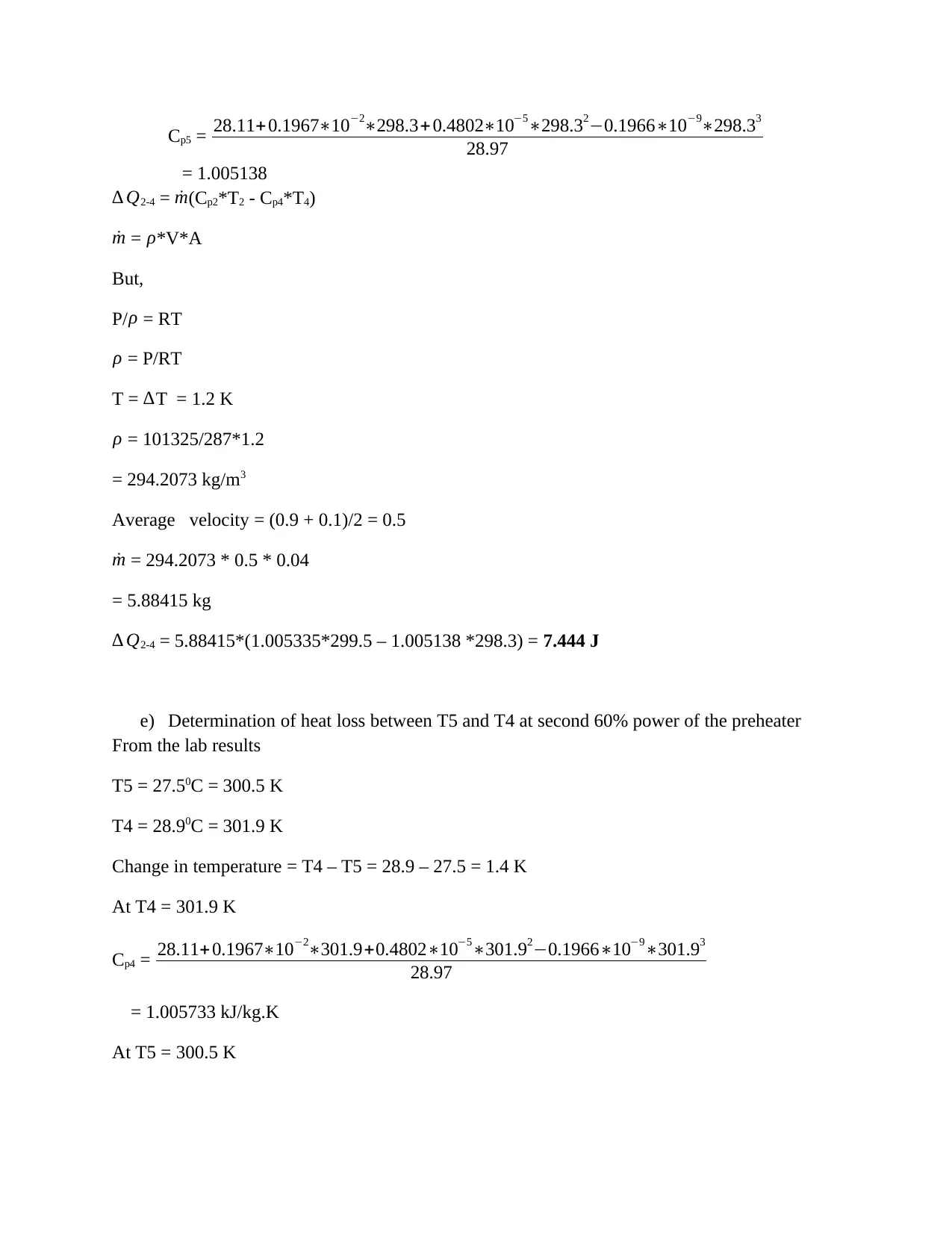
Cp5 = 28.11+0.1967∗10−2∗298.3+ 0.4802∗10−5∗298.32−0.1966∗10−9∗298.33
28.97
= 1.005138
∆ Q2-4 = ˙m(Cp2*T2 - Cp4*T4)
˙m = ρ*V*A
But,
P/ ρ = RT
ρ = P/RT
T = ∆T = 1.2 K
ρ = 101325/287*1.2
= 294.2073 kg/m3
Average velocity = (0.9 + 0.1)/2 = 0.5
˙m = 294.2073 * 0.5 * 0.04
= 5.88415 kg
∆ Q2-4 = 5.88415*(1.005335*299.5 – 1.005138 *298.3) = 7.444 J
e) Determination of heat loss between T5 and T4 at second 60% power of the preheater
From the lab results
T5 = 27.50C = 300.5 K
T4 = 28.90C = 301.9 K
Change in temperature = T4 – T5 = 28.9 – 27.5 = 1.4 K
At T4 = 301.9 K
Cp4 = 28.11+0.1967∗10−2∗301.9+0.4802∗10−5∗301.92−0.1966∗10−9∗301.93
28.97
= 1.005733 kJ/kg.K
At T5 = 300.5 K
28.97
= 1.005138
∆ Q2-4 = ˙m(Cp2*T2 - Cp4*T4)
˙m = ρ*V*A
But,
P/ ρ = RT
ρ = P/RT
T = ∆T = 1.2 K
ρ = 101325/287*1.2
= 294.2073 kg/m3
Average velocity = (0.9 + 0.1)/2 = 0.5
˙m = 294.2073 * 0.5 * 0.04
= 5.88415 kg
∆ Q2-4 = 5.88415*(1.005335*299.5 – 1.005138 *298.3) = 7.444 J
e) Determination of heat loss between T5 and T4 at second 60% power of the preheater
From the lab results
T5 = 27.50C = 300.5 K
T4 = 28.90C = 301.9 K
Change in temperature = T4 – T5 = 28.9 – 27.5 = 1.4 K
At T4 = 301.9 K
Cp4 = 28.11+0.1967∗10−2∗301.9+0.4802∗10−5∗301.92−0.1966∗10−9∗301.93
28.97
= 1.005733 kJ/kg.K
At T5 = 300.5 K
Paraphrase This Document
Need a fresh take? Get an instant paraphrase of this document with our AI Paraphraser
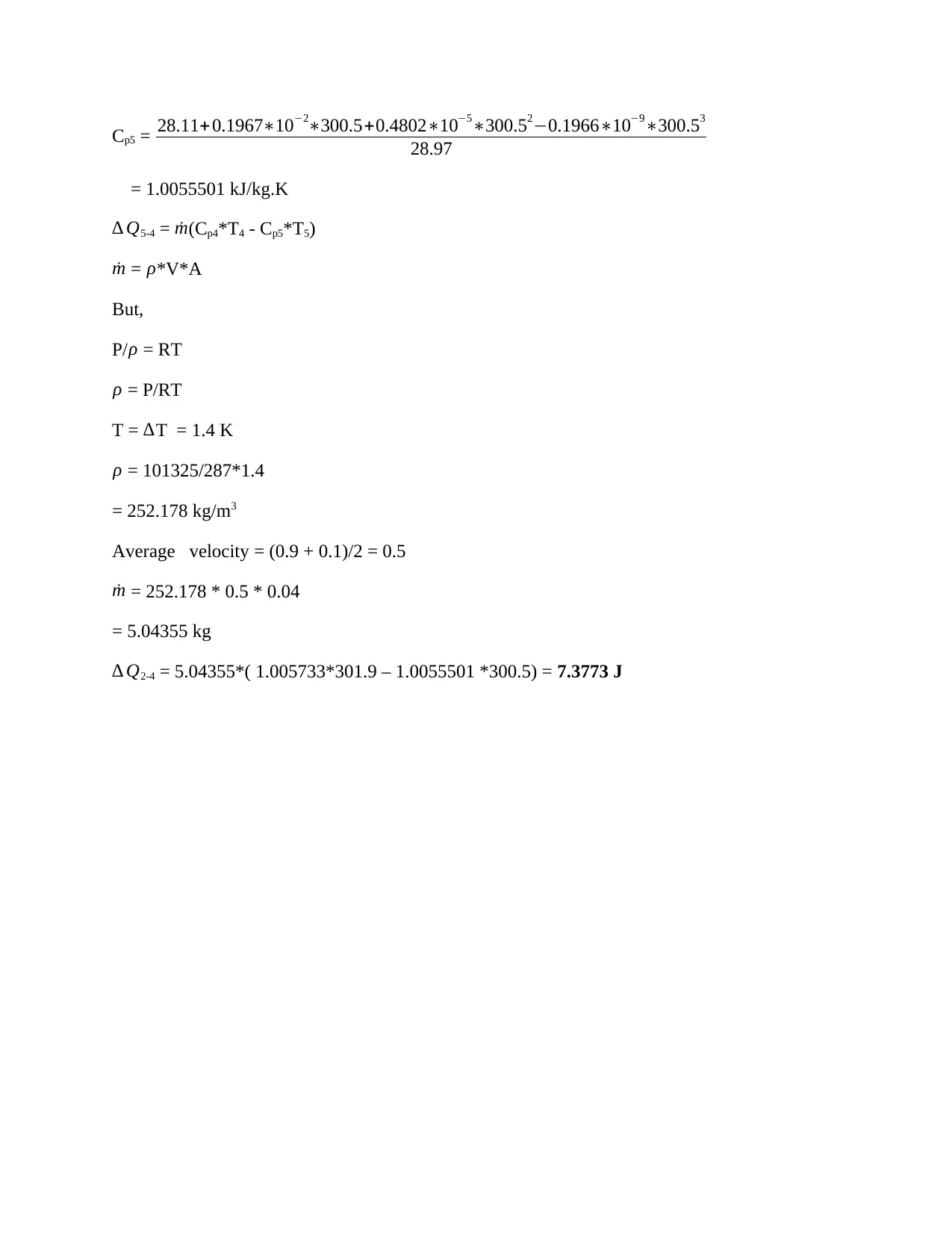
Cp5 = 28.11+0.1967∗10−2∗300.5+0.4802∗10−5∗300.52−0.1966∗10−9∗300.53
28.97
= 1.0055501 kJ/kg.K
∆ Q5-4 = ˙m(Cp4*T4 - Cp5*T5)
˙m = ρ*V*A
But,
P/ ρ = RT
ρ = P/RT
T = ∆T = 1.4 K
ρ = 101325/287*1.4
= 252.178 kg/m3
Average velocity = (0.9 + 0.1)/2 = 0.5
˙m = 252.178 * 0.5 * 0.04
= 5.04355 kg
∆ Q2-4 = 5.04355*( 1.005733*301.9 – 1.0055501 *300.5) = 7.3773 J
28.97
= 1.0055501 kJ/kg.K
∆ Q5-4 = ˙m(Cp4*T4 - Cp5*T5)
˙m = ρ*V*A
But,
P/ ρ = RT
ρ = P/RT
T = ∆T = 1.4 K
ρ = 101325/287*1.4
= 252.178 kg/m3
Average velocity = (0.9 + 0.1)/2 = 0.5
˙m = 252.178 * 0.5 * 0.04
= 5.04355 kg
∆ Q2-4 = 5.04355*( 1.005733*301.9 – 1.0055501 *300.5) = 7.3773 J
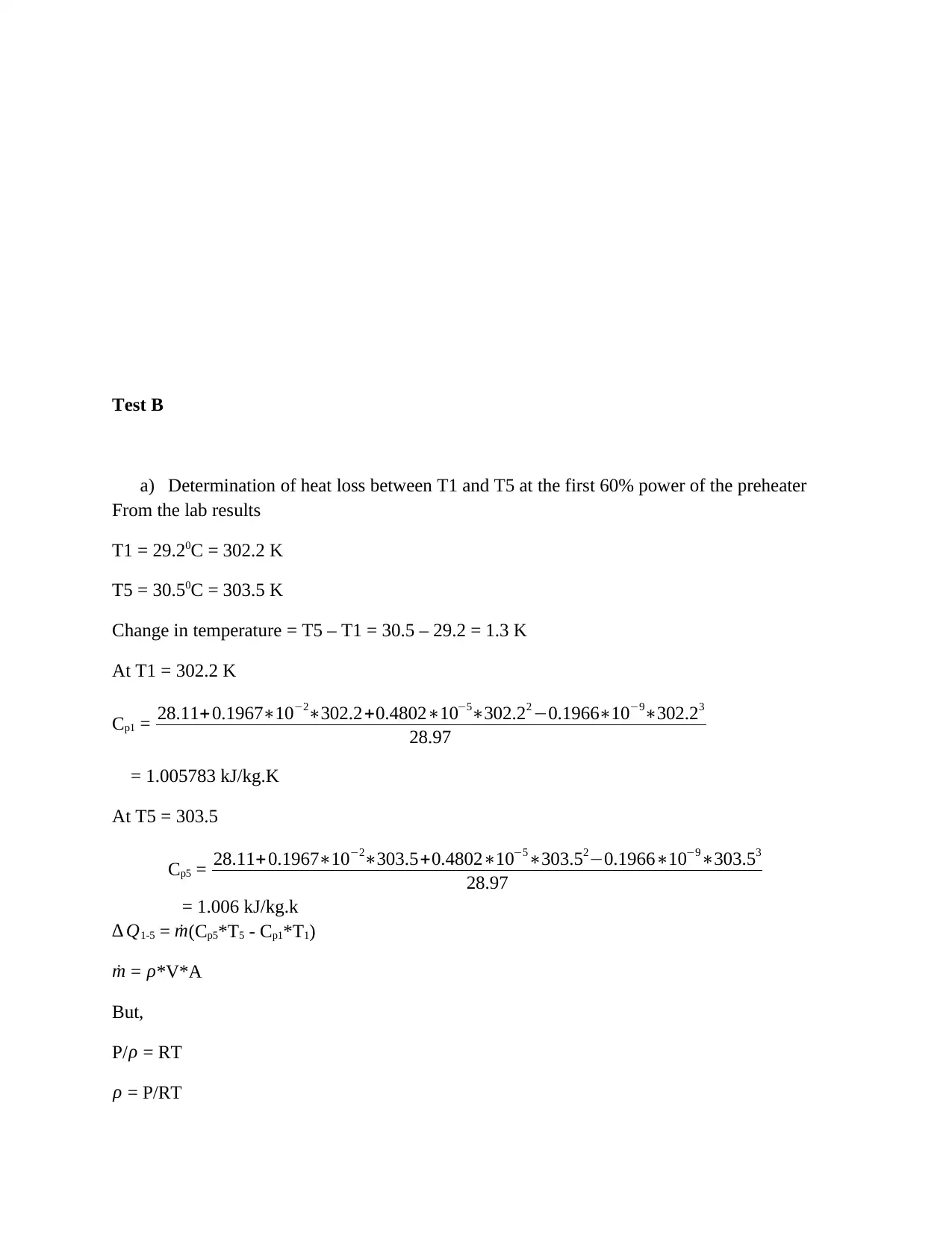
Test B
a) Determination of heat loss between T1 and T5 at the first 60% power of the preheater
From the lab results
T1 = 29.20C = 302.2 K
T5 = 30.50C = 303.5 K
Change in temperature = T5 – T1 = 30.5 – 29.2 = 1.3 K
At T1 = 302.2 K
Cp1 = 28.11+ 0.1967∗10−2∗302.2+0.4802∗10−5∗302.22 −0.1966∗10−9∗302.23
28.97
= 1.005783 kJ/kg.K
At T5 = 303.5
Cp5 = 28.11+0.1967∗10−2∗303.5+0.4802∗10−5∗303.52−0.1966∗10−9∗303.53
28.97
= 1.006 kJ/kg.k
∆ Q1-5 = ˙m(Cp5*T5 - Cp1*T1)
˙m = ρ*V*A
But,
P/ ρ = RT
ρ = P/RT
a) Determination of heat loss between T1 and T5 at the first 60% power of the preheater
From the lab results
T1 = 29.20C = 302.2 K
T5 = 30.50C = 303.5 K
Change in temperature = T5 – T1 = 30.5 – 29.2 = 1.3 K
At T1 = 302.2 K
Cp1 = 28.11+ 0.1967∗10−2∗302.2+0.4802∗10−5∗302.22 −0.1966∗10−9∗302.23
28.97
= 1.005783 kJ/kg.K
At T5 = 303.5
Cp5 = 28.11+0.1967∗10−2∗303.5+0.4802∗10−5∗303.52−0.1966∗10−9∗303.53
28.97
= 1.006 kJ/kg.k
∆ Q1-5 = ˙m(Cp5*T5 - Cp1*T1)
˙m = ρ*V*A
But,
P/ ρ = RT
ρ = P/RT
⊘ This is a preview!⊘
Do you want full access?
Subscribe today to unlock all pages.

Trusted by 1+ million students worldwide
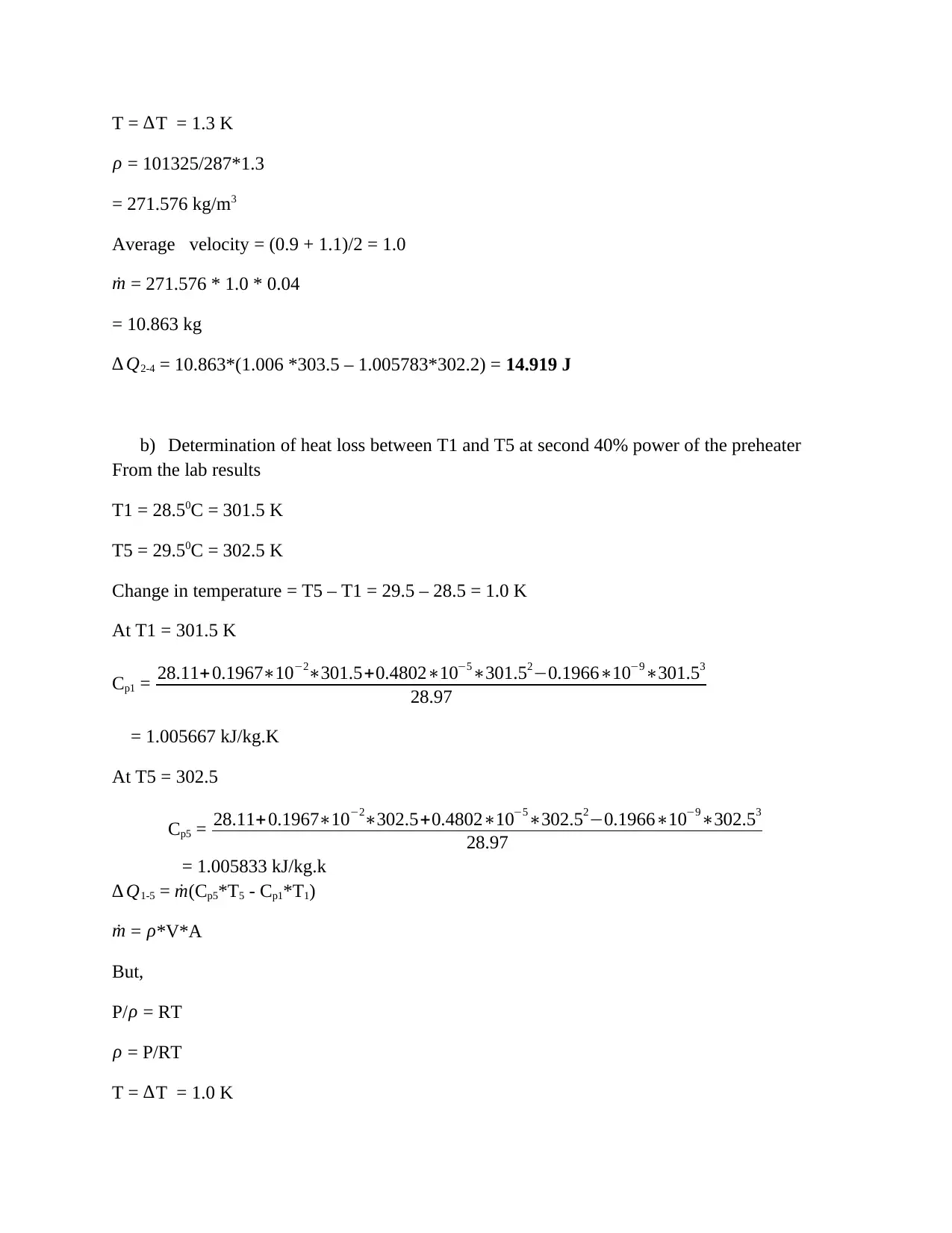
T = ∆T = 1.3 K
ρ = 101325/287*1.3
= 271.576 kg/m3
Average velocity = (0.9 + 1.1)/2 = 1.0
˙m = 271.576 * 1.0 * 0.04
= 10.863 kg
∆ Q2-4 = 10.863*(1.006 *303.5 – 1.005783*302.2) = 14.919 J
b) Determination of heat loss between T1 and T5 at second 40% power of the preheater
From the lab results
T1 = 28.50C = 301.5 K
T5 = 29.50C = 302.5 K
Change in temperature = T5 – T1 = 29.5 – 28.5 = 1.0 K
At T1 = 301.5 K
Cp1 = 28.11+0.1967∗10−2∗301.5+0.4802∗10−5∗301.52−0.1966∗10−9∗301.53
28.97
= 1.005667 kJ/kg.K
At T5 = 302.5
Cp5 = 28.11+0.1967∗10−2∗302.5+0.4802∗10−5∗302.52−0.1966∗10−9∗302.53
28.97
= 1.005833 kJ/kg.k
∆ Q1-5 = ˙m(Cp5*T5 - Cp1*T1)
˙m = ρ*V*A
But,
P/ ρ = RT
ρ = P/RT
T = ∆T = 1.0 K
ρ = 101325/287*1.3
= 271.576 kg/m3
Average velocity = (0.9 + 1.1)/2 = 1.0
˙m = 271.576 * 1.0 * 0.04
= 10.863 kg
∆ Q2-4 = 10.863*(1.006 *303.5 – 1.005783*302.2) = 14.919 J
b) Determination of heat loss between T1 and T5 at second 40% power of the preheater
From the lab results
T1 = 28.50C = 301.5 K
T5 = 29.50C = 302.5 K
Change in temperature = T5 – T1 = 29.5 – 28.5 = 1.0 K
At T1 = 301.5 K
Cp1 = 28.11+0.1967∗10−2∗301.5+0.4802∗10−5∗301.52−0.1966∗10−9∗301.53
28.97
= 1.005667 kJ/kg.K
At T5 = 302.5
Cp5 = 28.11+0.1967∗10−2∗302.5+0.4802∗10−5∗302.52−0.1966∗10−9∗302.53
28.97
= 1.005833 kJ/kg.k
∆ Q1-5 = ˙m(Cp5*T5 - Cp1*T1)
˙m = ρ*V*A
But,
P/ ρ = RT
ρ = P/RT
T = ∆T = 1.0 K
Paraphrase This Document
Need a fresh take? Get an instant paraphrase of this document with our AI Paraphraser
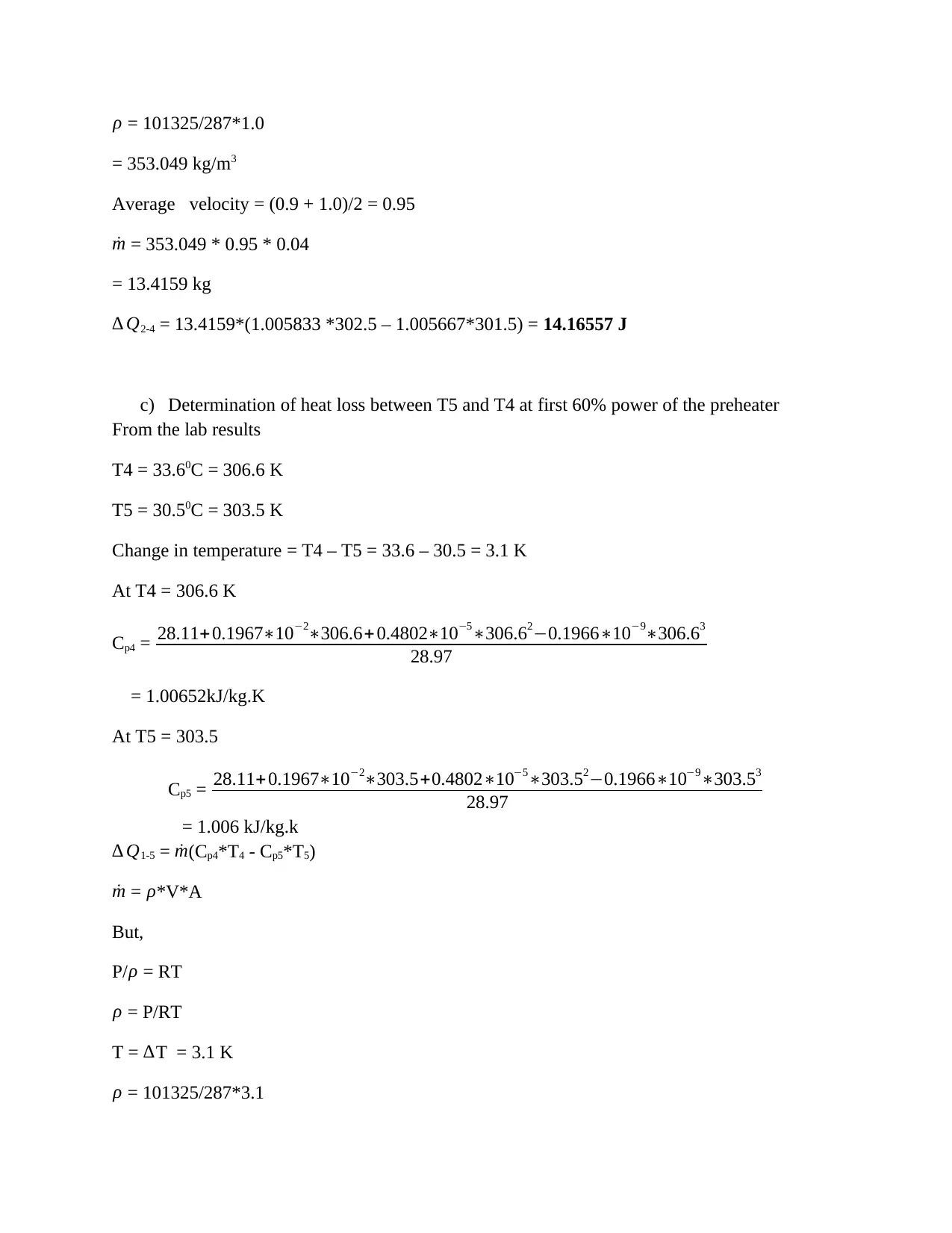
ρ = 101325/287*1.0
= 353.049 kg/m3
Average velocity = (0.9 + 1.0)/2 = 0.95
˙m = 353.049 * 0.95 * 0.04
= 13.4159 kg
∆ Q2-4 = 13.4159*(1.005833 *302.5 – 1.005667*301.5) = 14.16557 J
c) Determination of heat loss between T5 and T4 at first 60% power of the preheater
From the lab results
T4 = 33.60C = 306.6 K
T5 = 30.50C = 303.5 K
Change in temperature = T4 – T5 = 33.6 – 30.5 = 3.1 K
At T4 = 306.6 K
Cp4 = 28.11+0.1967∗10−2∗306.6+ 0.4802∗10−5∗306.62−0.1966∗10−9∗306.63
28.97
= 1.00652kJ/kg.K
At T5 = 303.5
Cp5 = 28.11+0.1967∗10−2∗303.5+0.4802∗10−5∗303.52−0.1966∗10−9∗303.53
28.97
= 1.006 kJ/kg.k
∆ Q1-5 = ˙m(Cp4*T4 - Cp5*T5)
˙m = ρ*V*A
But,
P/ρ = RT
ρ = P/RT
T = ∆T = 3.1 K
ρ = 101325/287*3.1
= 353.049 kg/m3
Average velocity = (0.9 + 1.0)/2 = 0.95
˙m = 353.049 * 0.95 * 0.04
= 13.4159 kg
∆ Q2-4 = 13.4159*(1.005833 *302.5 – 1.005667*301.5) = 14.16557 J
c) Determination of heat loss between T5 and T4 at first 60% power of the preheater
From the lab results
T4 = 33.60C = 306.6 K
T5 = 30.50C = 303.5 K
Change in temperature = T4 – T5 = 33.6 – 30.5 = 3.1 K
At T4 = 306.6 K
Cp4 = 28.11+0.1967∗10−2∗306.6+ 0.4802∗10−5∗306.62−0.1966∗10−9∗306.63
28.97
= 1.00652kJ/kg.K
At T5 = 303.5
Cp5 = 28.11+0.1967∗10−2∗303.5+0.4802∗10−5∗303.52−0.1966∗10−9∗303.53
28.97
= 1.006 kJ/kg.k
∆ Q1-5 = ˙m(Cp4*T4 - Cp5*T5)
˙m = ρ*V*A
But,
P/ρ = RT
ρ = P/RT
T = ∆T = 3.1 K
ρ = 101325/287*3.1
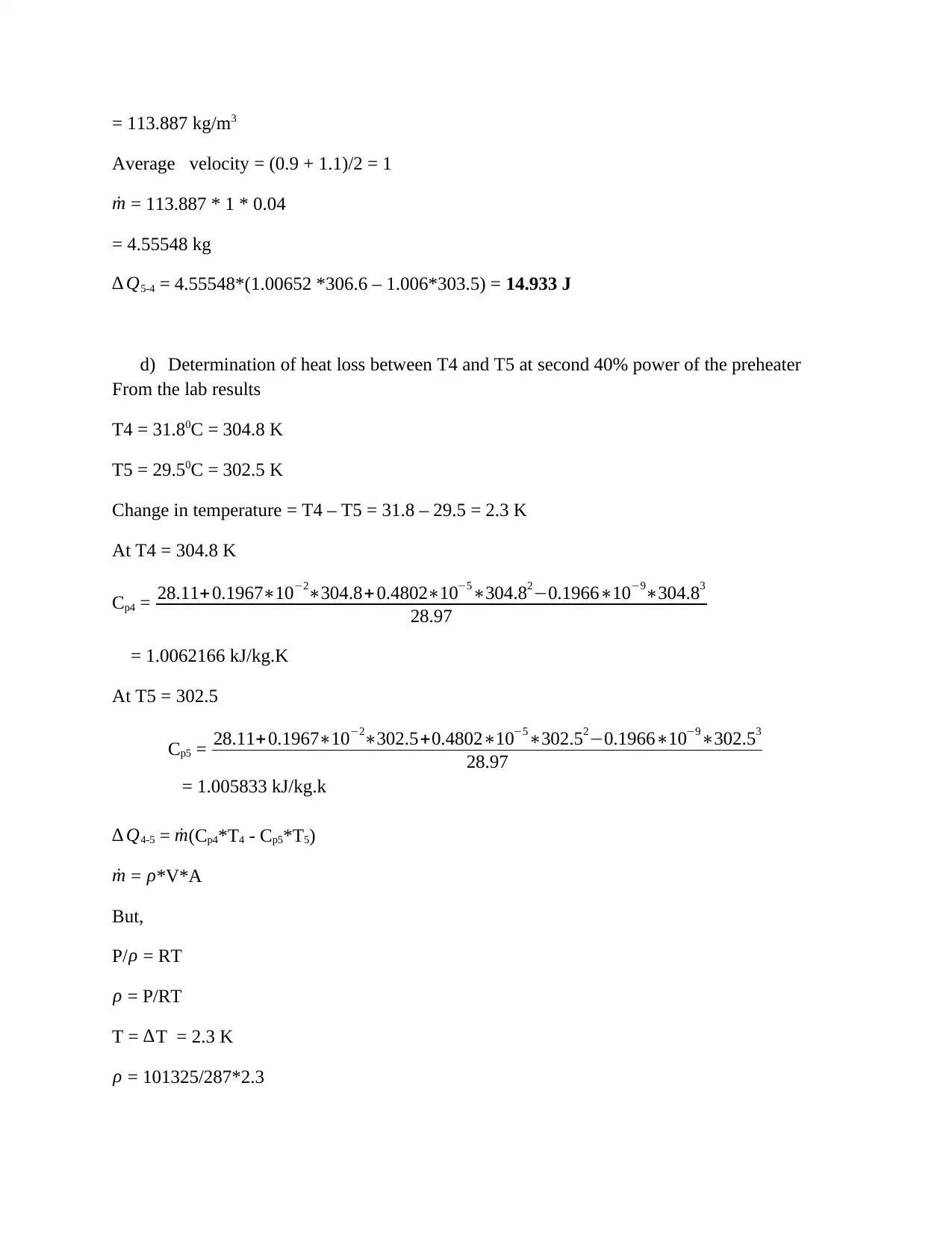
= 113.887 kg/m3
Average velocity = (0.9 + 1.1)/2 = 1
˙m = 113.887 * 1 * 0.04
= 4.55548 kg
∆ Q5-4 = 4.55548*(1.00652 *306.6 – 1.006*303.5) = 14.933 J
d) Determination of heat loss between T4 and T5 at second 40% power of the preheater
From the lab results
T4 = 31.80C = 304.8 K
T5 = 29.50C = 302.5 K
Change in temperature = T4 – T5 = 31.8 – 29.5 = 2.3 K
At T4 = 304.8 K
Cp4 = 28.11+0.1967∗10−2∗304.8+ 0.4802∗10−5∗304.82−0.1966∗10−9∗304.83
28.97
= 1.0062166 kJ/kg.K
At T5 = 302.5
Cp5 = 28.11+0.1967∗10−2∗302.5+0.4802∗10−5∗302.52−0.1966∗10−9∗302.53
28.97
= 1.005833 kJ/kg.k
∆ Q4-5 = ˙m(Cp4*T4 - Cp5*T5)
˙m = ρ*V*A
But,
P/ ρ = RT
ρ = P/RT
T = ∆T = 2.3 K
ρ = 101325/287*2.3
Average velocity = (0.9 + 1.1)/2 = 1
˙m = 113.887 * 1 * 0.04
= 4.55548 kg
∆ Q5-4 = 4.55548*(1.00652 *306.6 – 1.006*303.5) = 14.933 J
d) Determination of heat loss between T4 and T5 at second 40% power of the preheater
From the lab results
T4 = 31.80C = 304.8 K
T5 = 29.50C = 302.5 K
Change in temperature = T4 – T5 = 31.8 – 29.5 = 2.3 K
At T4 = 304.8 K
Cp4 = 28.11+0.1967∗10−2∗304.8+ 0.4802∗10−5∗304.82−0.1966∗10−9∗304.83
28.97
= 1.0062166 kJ/kg.K
At T5 = 302.5
Cp5 = 28.11+0.1967∗10−2∗302.5+0.4802∗10−5∗302.52−0.1966∗10−9∗302.53
28.97
= 1.005833 kJ/kg.k
∆ Q4-5 = ˙m(Cp4*T4 - Cp5*T5)
˙m = ρ*V*A
But,
P/ ρ = RT
ρ = P/RT
T = ∆T = 2.3 K
ρ = 101325/287*2.3
⊘ This is a preview!⊘
Do you want full access?
Subscribe today to unlock all pages.

Trusted by 1+ million students worldwide
1 out of 19
Related Documents
Your All-in-One AI-Powered Toolkit for Academic Success.
+13062052269
info@desklib.com
Available 24*7 on WhatsApp / Email
![[object Object]](/_next/static/media/star-bottom.7253800d.svg)
Unlock your academic potential
Copyright © 2020–2025 A2Z Services. All Rights Reserved. Developed and managed by ZUCOL.




